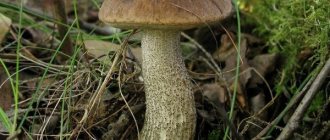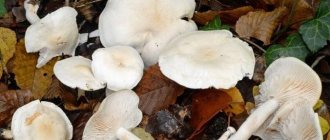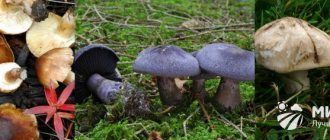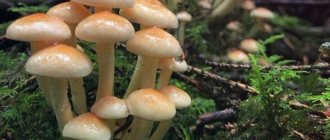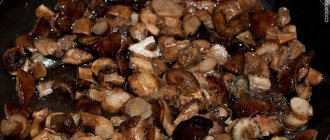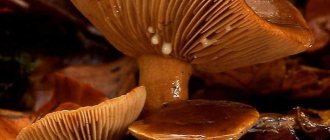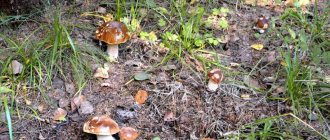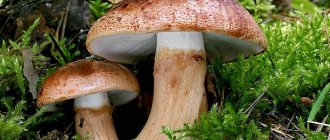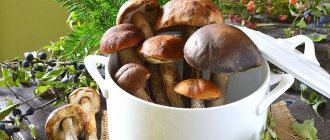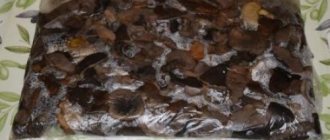The valuable boletus mushroom is one of the most popular in our country. It grows in deciduous forests, most often in birch forests - hence the name. Externally, boletus mushrooms are recognizable, but not everyone knows how to distinguish them due to the fact that there are many varieties of them that differ in appearance. Common names for boletus: birch cap, blackhead, obabok.
Characteristics
Boletus mushrooms are very similar in description and taste to porcini mushrooms, and they are also the closest relatives of boletus mushrooms.
And yet there are some differences, the main one of which is that the boletus mushroom turns black when cooked, while the white one does not change its noble shade.
Babies grow very quickly; in favorable conditions they can stretch up to 4 cm per day. By about 5-6 days, the fungus has fully matured, after which the active aging process begins. For this reason, obabki should not be stored unprocessed, even in the refrigerator. Once collected, they should be immediately peeled and boiled or frozen.
hat
The cap of a young boletus has a convex spherical shape. As the mushroom matures, it flattens out a little, becoming cushion-shaped, but even the old ones have a convex hat. The surface of the cap is smooth; after rain and in a humid environment, the thin skin becomes slimy, almost as “snotty” as that of an oil can.
Pulp
Dense, white, may turn slightly pink when cut. When broken, it emits a pleasant mushroom aroma. The lower part of the cap - the hymenophore - is tubular, white or gray.
During cooking, this part breaks down into fibers and will spoil the appearance of the dish, so it is usually removed. It is easily separated from the top layer.
In an old mushroom, the hymenophore is darker, and the flesh is more porous and watery. In addition, with age, the fruiting body quickly becomes wormy.
Leg
The strong, long white stem is not particularly valuable to culinary experts due to its fibrous structure. The legs of old boletus mushrooms become especially tough.
Black boletus
Its name comes from its dark cap, which can even be black. The mushroom has a voluminous but short stalk with dark growths.
This trophy does not often find its way into the basket of mushroom pickers, although it is highly valued by gourmets for its excellent taste.
Where and when do boletus grow?
As the name suggests, the habitats of the squirrels are determined by the presence of birch trees nearby. It is this tree that forms a symbiosis with the fungus: by merging with root systems, they help each other absorb nutrients from the soil.
And since the roots of a birch tree can stretch many meters underground, the boletus can easily be found at a distance from the tree.
Most often, little ones are found in a birch grove, a little less often - in mixed forests and even in spruce groves. They are also found in swampy areas, as well as on roadsides, along forest belts.
Interesting. Growing in Siberia, in the tundra and forest-tundra, boletus mushrooms are known for their gigantic size. Due to the fact that individual specimens easily reach 30-40 cm in height and can exceed dwarf birches in height, they are jokingly called “overbirch trees”.
The first harvest of bastards begins in June, when the bird cherry blossoms and the rye begins to spike. This is where another picturesque name for the mushroom comes from - “spikelet”.
The peak of active collection occurs at the end of July - mid-September. However, if the summer and autumn are characterized by warm and humid weather, the bastards breed in huge quantities, and even in early November they can be found in the forest.
In birch forests they most often grow in small groups; in mixed forests they are found mostly alone. Boletus mushrooms do not hide under leaves or tall grass; their round caps on long legs are clearly visible even to a less experienced mushroom picker.
What does boletus look like?
Despite the many varieties, the boletus looks quite recognizable: a dome-shaped cap on a long gray-white stem. Its closest relative, the boletus, has a similar appearance. And it’s not surprising, because both of them belong to the genus Leccinum. But, unlike the boletus, its red-headed brother turns blue at the break and has a more pronounced mushroom smell.
The diameter of the cap of an adult cape can reach up to 18 cm. The color varies from light gray to brown, depending on the variety and place of growth.
In wet ravines, light-headed specimens are more common, while in dense, dry forest the caps of spikelets are darker in color.
The light leg, covered with dark oblong scales, in its appearance resembles the tree under which the boletus grows. Its height can reach 15-17 cm, diameter - 3 cm in a mature fruiting body. It is wide at the base and narrows slightly towards the top.
Safety in the forest
As mentioned earlier, the forest is a high-danger zone; there is a risk of getting lost or getting into an unpleasant situation; to warn them, follow simple rules:
- Clothing should be comfortable and suitable for weather conditions.
- Raincoat - if you think it is necessary, then it is better to take it. An umbrella in this case is not very convenient, because... in your hands you will have a basket and a cane for searching for mushrooms.
- Shoes - It's best to wear comfortable and waterproof ones, especially if your run starts early in the morning, a lot of dew on the grass and leaves can make you uncomfortable.
- Navigation - during the search process, try to keep a path or some other landmark in your field of vision, you can use navigation on your phone, but cellular communications do not always work in the forest, as an option, take a GPS navigator with you, this device does not require cell towers, it keeps in touch with the satellite, but works well only in open areas, so in order to get your bearings, you need to go out into the open area before using it, so that there are no trees overhead.
- A basket or a bag - the best option is a basket; unlike a bag, the collected mushrooms will have access to air and be ventilated, as a result you will deliver them home fresh.
- Knife - for convenience and in order not to damage the mycelium, take it with you; the knife should be taken with a bright and visible handle so that it does not get lost in the grass.
- Have a snack - you can put a sandwich in your basket with you, or even better, a bar of chocolate, if hunger overtakes you during the hike, you will have something to answer it with.
- Be sure to take water with you, because... the feeling of thirst will definitely come; picking mushrooms is a very serious aerobic exercise.
- Mosquitoes and other game - to protect yourself from flying mosquitoes and ticks, be sure to take a cream or other means of protection.
- A search cane is a seemingly simple thing, but it can greatly simplify and secure your hikes in the forest. One of its functions is that you can push apart foliage or grass without bending over and identify the mushroom. And the second and most important thing is that various living creatures can be found in the forest, including... snakes, a cane will protect you from contact with them, since you won’t be pushing the grass apart with your hands!
Types of mushrooms
Obabkas come in many varieties and can look different. On the territory of Russia there are mainly 9 species of boletus, all of them are edible and differ in taste, external characteristics, conditions and place of growth.
Common boletus (Leccinum scabrum)
The most common type of obobka. It has an exquisite taste and a moderately pronounced mushroom aroma, making it very popular in the culinary world.
The appearance of the mushroom has the following features:
- the color of the cap is uniform, most often reddish or brownish, less often gray or white;
- the large (up to 15 cm in diameter) cap of young mushrooms is velvety, becoming smoother with age;
- the long white leg is covered with dark grayish or brownish scales, coarser at the base;
- immature mushrooms have a barrel-shaped stem; in adult specimens, the stem is thickened at the bottom and narrows towards the top;
- the flesh is white or with a slightly pinkish tint.
Gray boletus, hornbeam (Leccinum carpini)
Found mainly in deciduous forests of the Caucasus. The peculiarity of this species is that it grows at the very base of the hornbeam, often right on the roots of the tree.
Peculiarities:
- the cap has rolled edges, the surface is velvety, slightly wrinkled;
- the color of the cap has an ashy, grayish tint, olive-brown or brown;
- the flesh of the cap is soft, not too dense;
- when cut, the flesh changes color from blue-violet to gray and black;
- the scales on the stem of a young specimen are white, turning yellow as they grow older, acquiring a brown tint towards the end of ripening;
- the upper part of the leg is lighter and thinner than the base.
Stiff boletus (Leccinum duriusculum)
Although the mushroom is called boletus, it may well form mycorrhiza with aspen or poplar.
Description:
- the cap is usually brown, sometimes gray-brown and even light purple. High humidity makes it very slimy, with drooping edges;
- the bottom layer of the cap is white, darkens greatly when pressed;
- The flesh of the mushroom is hard and white. However, at the break, the cap turns slightly red, and the base of the stem acquires a bluish tint, gradually turning into dark gray;
- the stem is barrel-shaped, thick in young mushrooms and long, cylindrical in mature ones;
- the base is noticeably thickened, often pointed, with bluish or greenish spots.
Marsh boletus (Leccinum holopus)
It grows mainly in damp places: in young birch trees, in thick moss, near forest swamps, on peat soils. You can collect from early May to mid-autumn:
- the color of the cap is very light, from white to pale brown;
- the tubular layer is white, darkens significantly with age;
- the leg is very long, thin, white or grayish in color;
- The pulp is white, loose, does not change color when cut, the taste and smell are weakly expressed.
Black boletus, black cap (Leccinum melaneum)
Quite a rare species, but extremely tasty and valuable among culinary specialists. It is collected from early August to November:
- the gray-black or brown cap becomes even darker as the mushroom matures;
- the leg is short, thick, cylindrical, with a slight thickening at the bottom;
- the surface is white, covered with gray or black scales;
- The pulp is dense, with a pleasant mushroom aroma, white in color, sometimes turning slightly blue when cut.
Pink boletus (Leccinum oxydabile)
More often found in tundra and northern forests, as well as in mountainous areas. It is more of an autumn mushroom; its peak yield occurs in August – September:
- a dome-shaped cap with slightly wavy edges;
- the color scheme is usually red-brown or yellow-brown, often marbled in color with light splashes;
- the leg is short, cylindrical, covered with large brown or brown scales;
- the flesh is white, dense, turns pink when cut, then darkens;
- When wet, it quickly absorbs moisture and becomes loose.
Checkerboard boletus (Leccinum nigrescens)
Distributed mainly in warm European latitudes and the Caucasus. Peak yields occur in the summer months and early September:
- the dome-shaped cap is usually yellow-brown in color, with dry, often cracking skin;
- the bottom layer is yellow, when pressed it becomes brownish-purple;
- the leg thickens downwards. It can be white or slightly yellow, with yellow-brown scales;
- the pulp has a yellow tint, is red or brown at the break with a purple tint, and subsequently turns black.
Interesting fact! Among mycological scientists, this type of boletus is usually called Obabok Checkerboard. This name more accurately characterizes this mushroom, because it has nothing to do with birch, forming mycorrhiza with the roots of beech or oak.
Ash gray boletus (Leccinum leucophaeum)
It has a very mediocre smell and taste, the peak of fertility occurs in the autumn months:
- contrary to the name, the cap of this mushroom is mostly brown, smooth and dry;
- the lower part is white, becoming smoky as it ripens;
- the leg is thin and long, has a thickening in its lower part and is covered with dark scales;
- When cut, the flesh is white, but quickly turns pink, and at the base of the stem it becomes bluish.
Variegated boletus (Leccinum variicolor)
More often this species can be found in the southern part of Russia; the mushroom is not typical for northern latitudes. Fruits from June to October, grows in wet, marshy, mossy areas:
- the color scheme is very diverse and varies from light, almost white, to dark brown;
- multi-colored got its nickname because of the characteristic markings and streaks of various shades on the surface of the hat;
- the cap is relatively small, with smooth skin hanging over the edges;
- the tubular layer is light or brownish-gray, and may turn pink when pressed;
- the white leg is cylindrical in shape and densely covered with brown scales;
- the flesh is colored and also corresponds to the name: when cut, the cap turns pink, the spongy layer turns blue, and the leg acquires a bluish or greenish tint;
- The dense pulp becomes more porous as it ages and has a sour aroma.
Self-cultivation of boletus mushrooms
The famous boletus mushroom can be grown independently, on a garden plot or in a specially designated area, not only for personal use, but also for sale. The business is profitable and does not require much hassle. In addition, compared to other mushrooms, boletus mushrooms are famous for their high yield. You just need to properly care for the garden bed. It is better to plant mushrooms in May-June.
The most difficult thing is to obtain the mycelium of the fungus. Boletus mushrooms are distinguished by the fact that their spores are difficult to separate from the pulp. Knowing this, manufacturers of ready-made mycelium sell boletus substrate ready for planting. This saves the future farmer's time. The cost of a 60 ml package is small - up to 200 rubles. If it was not possible to obtain ready-made mycelium for planting, you need to prepare a mixture that will precipitate the mature spores.
How to germinate mushrooms naturally? First of all, you need to get the spores. They are contained in the mushroom pulp, which must be separated from the cap, minced through a meat grinder and placed in a container with water. Further scheme of action:
- Dry yeast is added to the mixture - a nutrient medium for the propagation of spores.
- The liquid is infused for a week. Then the foam is removed from the surface, the water (the middle part) is drained, and the sediment - these are the spores - is diluted in a new portion of water. Ratio – 1:100.
- This liquid is poured into the birch roots, which must first be opened.
- The area is moistened again.
This is the main condition for germinating mushrooms - maintaining the recommended humidity level. The soil should be sprayed regularly from a spray bottle, simulating mushroom rain. It is advisable to water in the afternoon so that the sun's rays do not dry out the soil. It is good when there are several low plants next to the planting that will protect the clearing from direct exposure to ultraviolet radiation.
The technology for growing boletus mushrooms is to create conditions that are as similar as possible to their natural growth environment.
If ready-made mycelium is available, it can be planted in pre-prepared holes in accordance with the instructions on the package. Don't be overzealous; 3-4 holes for seeds are enough. Their depth is on average 20 cm, diameter - 10. They are placed around the circumference of a tree (birch), preferably not a young one, over 5 years old. It is good when there are several trees, perhaps they are mixed with other species.
How to germinate mushrooms in holes:
- Birch sawdust (or soil with a high peat content) is placed in the prepared holes, followed by forest humus. Then a small piece of compost mycelium is placed. 1/3 of the bag per 1 hole, if the product is ready.
- Each depression is filled and compacted.
- The holes are watered abundantly - at least a liter of water. You can add fertilizer or use preparations containing microorganisms for watering.
- It is also necessary to moisten the soil around the plantings.
- To maintain moisture, the planting is covered with a layer of straw, which is constantly watered, with moss or leaves. The plantation should be moistened at least once a week, at least 3 buckets of water are poured under each hole during this period.
- With the onset of cold weather, straw is replaced with leaves or moss. It is recommended to cover the area within a radius of 2 meters (at least during the first winter) with insulating material: both the holes themselves and tree roots. The covering layer is removed with the first warming.
The planted seeds will produce their first harvest only after a year. After this, active fruiting will be observed for 5-7 years. At this time, you can expand the plantation and make new holes. The volume of the harvest depends on how the growing conditions were maintained. It is also important to choose the right variety of mushrooms that will grow on the site. Their natural distribution area and weather conditions should be similar to artificially created ones.
The advantage of growing boletus mushrooms yourself is the opportunity to harvest young mushrooms. They are tastier, stronger than adult specimens, which become loose over time, and are suitable for any dish - pickling, soup, roast. Timely collection will not allow boletus mushrooms to deteriorate in the garden, lose their valuable taste and be attacked by worms, slugs and other harmful insects.
The boletus is a tasty mushroom that mushroom pickers enjoy hunting for. It is good in any dish, has no contraindications for consumption, and is famous for its excellent taste. Big fans of this mushroom can grow it themselves if they wish. If a birch tree grows on or near your summer cottage, you can plant several beds with pre-prepared mycelium around it, and wait for the results for the next season.
0
0
Copy link
Benefits of boletus
Despite the fact that mushrooms consist of 90% water, and many do not consider them a serious product at all, boletus has many useful qualities:
- Obabok is very rich in vitamins B, A, E, PP, and also contains ascorbic acid.
- Minerals occupy far from the last place in the composition of boletus. A high concentration of potassium, phosphorus, calcium, manganese, sodium and iron make this product not only tasty, but also healthy.
- A big plus for those who want to lose weight: 100 grams of boiled mushrooms contain only 20 Kcal.
- Obabok contains a lot of fiber, it has antioxidant properties and removes toxins from the body.
- In folk medicine, boletus is actively used to prevent diseases of the nervous system, regulate blood sugar, improve blood circulation, and treat kidney and musculoskeletal diseases.
- The pulp from dried birch trees is used as a rejuvenating and anti-inflammatory agent, and infusions have wound-healing properties. In cosmetology, decoctions of fruiting bodies are used to rinse hair, strengthen nails and tone the skin.
How to identify false boletus
There are mainly 2 types of mushrooms disguised as tasty and healthy mushrooms: gall and pepper. They are not poisonous and will not cause harm, but they can significantly spoil the taste of the finished dish. Once there, even in small quantities, they will provide a bitter aftertaste to any culinary masterpiece.
Peppery
The gall mushroom can be distinguished from the boletus mushroom by the following characteristics:
- If the cap has a greenish tint, pass by this mushroom. The obobka does not have green in the color of his cap.
- The boletus mushroom is easily distinguished by its characteristic scales on the stalk; the gall mushroom does not have them; its pattern is replaced by a mesh.
- The tubular layer of the gall fungus has a subtle pink tint, especially on the inside. When damaged or pressed, the hymenophore becomes brown or reddish in color.
The gall
pepper mushroom, which is similar to the eggplant, also lacks scales on a thin stalk, is much smaller in size and grows mainly in coniferous areas.
Reference. Both gall and pepper mushrooms can be quite useful: the first has good medicinal potential, and the second, in small quantities, will serve as an excellent spicy seasoning.
Grabovik
This variety of boletus can have a cap of different colors: gray, brown white, ash or ocher.
Grows in the southern latitudes of Russia. Most often found in deciduous forests in the Caucasus, especially in hornbeams.
The value of boletus
In cooking, obabok stands alongside boletus and butterdish, in no way inferior to them in taste. Spikelets do not need to be soaked, like milk mushrooms, for example; their flesh is not bitter and has a very delicate consistency.
It can be prepared in any way: boiled, fried, dried and baked, salted and pickled. Even just frozen, boletus mushrooms are subsequently used in various dishes: soups, side dishes, pasta, as a filling for rolls and pies, making caviar and mushroom mushrooms.
Obabkas are good, stewed with sour cream, cooked on the grill with chicken, onions and eggplants, as part of spaghetti sauce and noodles. Boletus mushrooms are amazing both on their own and in combination with chanterelles, honey mushrooms, boletus or champignons.
Answers to frequently asked questions from users
How can you tell if a mushroom is old and should not be eaten?
The caps of old mushrooms are more flattened, loose and, as a rule, wormy. If you find such a fruit, place it in a tubular layer on the ground and, if possible, water it with water. This will contribute to better crop yields in subsequent years.
Boletus mushrooms are very tasty and beloved by many mushrooms. Knowing all the details about the time and place of their collection, as well as storage and preparation, you can delight yourself and your loved ones with amazing dishes all year round.
Contraindications
Healthy, tasty boletus mushrooms are among the best edible species, but dishes made from them should absolutely not be eaten by people suffering from gastritis, duodenal ulcers, hepatitis of any etiology, or inflammatory processes in the gallbladder.
Some people may experience individual intolerance, which is characterized by allergic reactions, and with insufficient activity of gastrointestinal enzymes, digestive problems arise, which are expressed by nausea, indigestion, and fermentation processes in the intestines.
Not recommended for consumption by people with clinical manifestations or a tendency to allergies, as well as children under seven years of age, pregnant and lactating women.
